Create a free profile to get unlimited access to exclusive videos, sweepstakes, and more!
Asteroid glass on the Moon provides a window into dino-killing impacts
They are admittedly very tiny windows.

In 1962, John F. Kennedy gave a speech at Rice University which became an integral part of the United States’ national story. In it, he made a promise that by the end of the decade, just eight short years away, we would see human astronauts walking on the Moon. It was the political and scientific equivalent of Babe Ruth calling a shot and nailing a home run; risky but immensely cool. Six months before the clock ran out, in July of 1969, NASA made good on JFK’s promise, delivering Neil Armstrong and Buzz Aldrin to the lunar surface — with Michael Collins driving the getaway vehicle — and returning them safely home.
2019 marked the 50 year anniversary of Apollo 11 and filmmaker Todd Douglas Miller revisited the famed mission in the aptly named documentary Apollo 11. Over the course of six more missions, with the notable exception of Apollo 13, astronauts collected more rocks than a kid on a family hike, filling their figurative pockets with 842 pounds of material. We’ve been studying those samples for more than 50 years, learning not just about the Moon but about our own home as well. For decades, those hand-picked samples have been the only material we’ve had to work with, aside from the occasional lunar meteorite which made their way here the old fashioned way.
Recently, however, owing to China’s lunar activities, we’ve gotten our hands on some new samples and they’re already resulting in new and exciting science. The Chinese lunar program, named after the Chinese Moon goddess Chang’e, launched its fifth mission in November of 2020. The Chang’e-5 spacecraft landed at Oceanus Procellarum, otherwise known as the Ocean of Storms, a week later. It spent two days collecting rocks before returning home. It was the first lunar return mission since the Soviet Union’s Luna 24 mission in 1976.
Since Chang’e-5’s return to Earth, ferrying a new load of lunar samples, scientists around the world have been digging their proverbial fingers into the Moon dirt to see what they could find. Recently, those efforts paid off when scientists analyzed a collection of small glass particles documenting the history of asteroid impacts not just on the Moon but also on Earth. The findings were published in the journal Science Advances.
Oceanus Procellarum is a lunar mare more than 1,800 miles wide believed to have been formed by a massive impact. The location for Chang’e-5’s landing was chosen for its suspected young geologic age and the likelihood of interesting geological features for study. The samples confirmed scientists’ suspicions and contained countless small glass particles known as spherules.
On the Moon, natural glass is formed in two main ways, through volcanic activity and through impact. They are a common feature of lunar soils and range in size from micrometers to millimeters in diameter. They are generally spherical, ovular, or teardrop shaped, and we can use their chemical and textural characteristics to determine generally how and when they were formed.
The team selected 215 glass particles for close study and modeled the ways in which they could have been formed. Using various analytical techniques, including modeling and geological surveys, researchers confirmed that these glass spherules are consistent with having formed through the intense heat and pressure of an impact.
That, in and of itself, isn’t all that surprising. If you’ve ever had a chance to look up at the Moon, it’s immediately clear that it has been bombarded by impactors over the course of its existence. The scars remain readily visible, written on its face. What’s interesting about this Moon glass is the timing of its creation.
When dating the ages of the glass formation, researchers found that they coincide with some of the most well-known impacts of our own planet, including the kilometers-wide asteroid which caused the extinction of the dinosaurs along with roughly three quarters of all life on Earth 66 million years ago.
The idea is that large impactors don’t travel alone. Instead, they bring with them an entourage of smaller objects which strike anything in their path. It’s less like a cosmic sniper shot and more like a load of celestial buckshot, spread out over a wide area. There’s some support for this idea of impactors traveling in gangs. Recently, researchers discovered a potential underwater impact crater which might have struck around the same time as the dinosaur killer. If there were more than two objects in a sort of impact cluster, it stands to reason that one or more of them might have missed Earth and hit the Moon instead.
If that’s the case, it means we can look to the Moon to gain insight into the history of impactors on Earth as well as other locales in the inner solar system. Researchers intend to investigate other impact sites on the Moon in the hope of gaining insight about the impact history of Earth. You may not be able to gaze into the past through a crystal ball, but you can do it with a glass spherule.



























